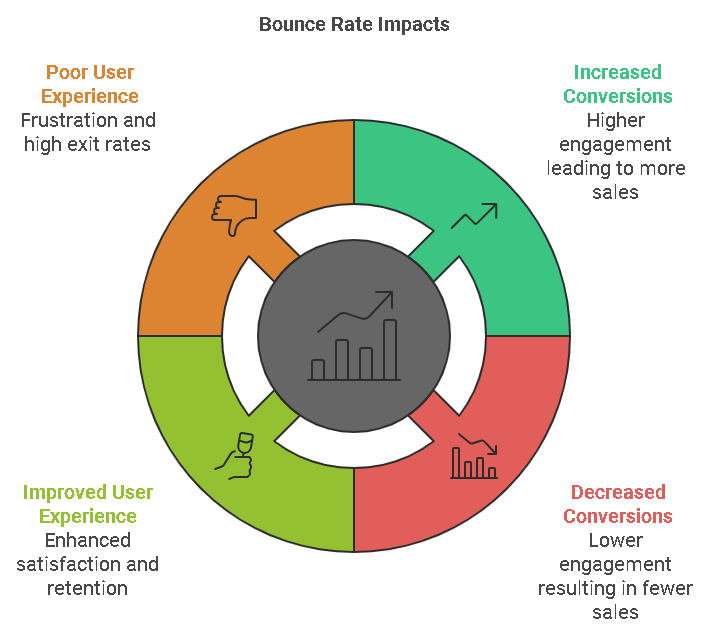In the world of digital marketing and website performance, bounce rate and conversion rate are two of the most important metrics that business owners, marketers, and website managers focus on. While these terms are often discussed in the same breath, understanding their relationship and individual implications can help businesses optimize their websites for better user engagement and, ultimately, higher sales. This article delves deep into the concept of bounce rate, its impact on conversion rates, and how you can leverage both to boost your website’s performance. Whether you are working on improving your own website or seeking professional help, CRO Expert is here to assist you in optimizing your website for both better bounce rates and higher conversions.
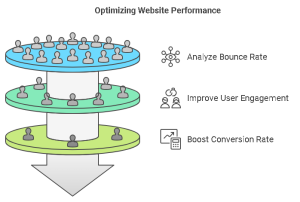
What is the Bounce Rate?
Bounce rate refers to the percentage of visitors who land on a webpage and leave without interacting further, such as clicking on links, navigating to other pages, or filling out forms. In simple terms, if a person visits your website, looks at one page, and then leaves without exploring the site further, it counts as a bounce.
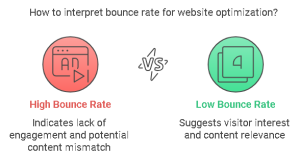
Bounce rate is typically measured in percentage form and is often tracked through website analytics tools like Google Analytics. A high bounce rate can indicate that users are not finding what they expect or want on your site, or that they are not engaging with your content in a meaningful way. Conversely, a low bounce rate often suggests that visitors are interested in exploring more of your content.
Why is Bounce Rate Important?
Understanding bounce rate is crucial because it is a direct indicator of user engagement. If your bounce rate is high, it means your visitors aren’t sticking around to engage with the content or services you offer. This could suggest several problems, such as:
- Unappealing content: If the content on your website is not relevant, engaging, or helpful to your visitors, they are likely to leave quickly.
- Slow page load times: Users expect fast-loading websites, and slow-loading pages can frustrate visitors, leading them to bounce before the page even fully loads.
- Poor user experience (UX): If your website’s design or navigation is confusing, visitors may leave without engaging further.
- Irrelevant traffic: If your website attracts visitors who are not truly interested in what you offer, your bounce rate will naturally be higher.
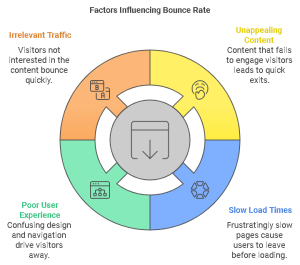
However, a high bounce rate doesn’t always mean a bad thing. For instance, on blog pages or informational sites, a visitor might land on a page, find the information they were looking for, and leave, which is still a successful user experience, even though it counts as a bounce.
What is Conversion Rate?
Conversion rate, on the other hand, measures how many visitors to your website take a desired action, such as making a purchase, filling out a contact form, subscribing to a newsletter, or downloading an ebook. It is the percentage of visitors who convert into customers or leads, depending on your business goals.
Formula for Conversion Rate

Conversion rate optimization (CRO) is an ongoing process that aims to increase the percentage of visitors who take a desired action on your site. Improving your conversion rate can significantly boost your revenue, especially if you’re able to maintain or even reduce your marketing spend while increasing conversions.
How Bounce Rate Affects Conversion Rate
Now that we understand what bounce rate and conversion rate are, let’s dive into how they are connected.
A high bounce rate can directly impact your conversion rate in a negative way. If visitors leave your website without interacting with your content or taking action, they are less likely to convert into customers. Therefore, a high bounce rate usually suggests that visitors are not finding what they are looking for or aren’t sufficiently engaged to take the next step.
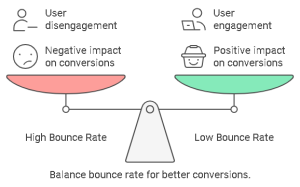
However, it’s essential to consider the context. For some types of pages—such as landing pages or blog posts—a high bounce rate might not have a detrimental effect on conversion rates. For example, a user may visit a blog, find the information they need, and leave without clicking further. In this case, the bounce is not a bad thing, as the user’s needs were met.
On the flip side, if your goal is to sell products or gather leads, and your bounce rate is high, it’s likely that users are not engaging enough with your content to move forward in the conversion process. This is a situation where improving bounce rate is crucial for boosting conversion rates.
How to Lower Bounce Rate and Improve Conversion Rates
If your website has a high bounce rate and low conversion rates, it’s time to analyze your website and make some improvements. Here are several strategies to help lower your bounce rate while also improving your conversion rates:
1. Improve Your Website’s Load Speed
A slow-loading website is one of the most common causes of high bounce rates. According to studies, 40% of visitors will leave a page if it takes more than 3 seconds to load. Google’s PageSpeed Insights tool is a great resource to analyze your website’s performance and identify areas for improvement.
To speed up your website, consider the following actions:
- Compress large images
- Minimize HTTP requests
- Use content delivery networks (CDNs)
- Optimize your website’s code and scripts
At CRO Expert, we help optimize page load speeds, ensuring your website delivers a seamless experience that retains visitors.
2. Enhance User Experience (UX)
A user-friendly, intuitive website is essential for reducing bounce rate. If users can’t find what they’re looking for quickly or if the design is overwhelming, they will likely leave.
Here are some UX best practices to improve your website’s performance:
- Simplify your navigation
- Ensure your website is mobile-friendly
- Make your call-to-action (CTA) buttons clear and prominent
- Improve readability with concise, well-organized content
- Use high-quality images and multimedia
At CRO Expert, we specialize in optimizing user experience to ensure your visitors stay engaged and explore more of what you offer.
3. Target the Right Audience with Quality Traffic
A high bounce rate can sometimes stem from attracting the wrong kind of traffic to your website. If visitors arrive at your site through irrelevant search terms or ads, they are unlikely to stay long. Make sure your marketing efforts are targeting the right audience by:
- Conducting thorough keyword research
- Refining your paid ad targeting (e.g., Google Ads)
- Analyzing your audience demographics
CRO Expert can help you refine your targeting strategies to bring in quality traffic that is more likely to convert.
4. Provide Engaging, High-Quality Content
Content is king when it comes to retaining visitors and reducing bounce rates. If your content is informative, well-written, and engaging, users are more likely to stay on your site longer. Regularly update your content and make sure it answers the specific questions your audience is searching for.
5. Use Internal Linking to Encourage Further Exploration
Internal linking can help guide visitors to other pages on your website and encourage them to explore more of your content. This increases the chances of conversion and reduces bounce rates. For instance, within blog posts, you can link to related articles, product pages, or case studies.
6. Optimize Your Landing Pages
If your primary goal is conversions, focus on optimizing your landing pages. This includes:
- Crafting a compelling headline
- Having a clear and concise offer
- Simplifying forms and removing unnecessary fields
- Using trust signals such as testimonials or secure payment icons
Our team at CRO Expert has extensive experience in optimizing landing pages for maximum conversions.
7. Offer Social Proof and Trust Signals
Visitors are more likely to convert if they feel confident about your brand’s credibility. Incorporate trust signals such as customer reviews, testimonials, industry certifications, and social media proof to reassure users that they’re making the right choice.
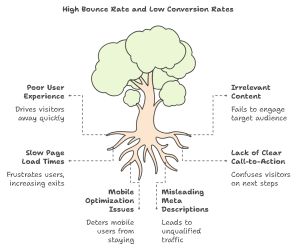
FAQ Section
- What is a good bounce rate for a website?
A good bounce rate varies depending on the type of website and its goals. In general, a bounce rate between 26% and 40% is considered excellent. A bounce rate between 41% and 55% is average, while anything above 55% may indicate that there is an issue with the site’s content or user experience. - Does a high bounce rate always mean poor website performance?
Not necessarily. Some websites, especially blogs or informational pages, may have high bounce rates without it being an issue. If visitors find the information they need on the first page and leave, that’s still a successful outcome. - How do I track bounce rate?
Bounce rate can be tracked through website analytics tools like Google Analytics. You can view bounce rate metrics for specific pages or the entire site to identify areas that need improvement. - Can a high bounce rate affect SEO rankings?
A high bounce rate can indirectly affect your SEO performance. Google uses various user engagement signals to determine how well a page meets user intent. If your bounce rate is high, it might indicate that users aren’t finding what they expect, which could impact rankings. - What is the difference between bounce rate and exit rate?
Bounce rate refers to visitors who leave after viewing only one page, while exit rate is the percentage of visitors who leave a page after having viewed other pages on the site. Both metrics provide insights into user behavior but are distinct from each other. - How does the type of website affect bounce rate?
E-commerce sites, for example, typically aim for a lower bounce rate as visitors should ideally browse products before making a purchase. In contrast, blogs may experience a higher bounce rate since visitors might leave after reading a single post. - What role do call-to-action (CTA) buttons play in conversion rates?
Effective CTAs guide visitors toward taking the desired action, such as purchasing or subscribing. Clear, compelling CTAs can help improve conversion rates by making it easy for users to engage with your offerings.
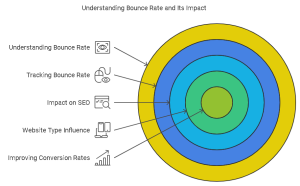
Conclusion
Bounce rate and conversion rate are intertwined metrics that significantly influence the success of your website. While a high bounce rate can indicate problems with user engagement, improving it requires a well-rounded approach to website optimization. Focus on improving the user experience, targeting the right audience, offering valuable content, and optimizing for conversions. With consistent effort, you can reduce bounce rates and increase conversion rates, leading to a more successful website that drives business growth.
If you need professional help in optimizing your website for better bounce rates and conversions, CRO Expert is here to help. Visit croexpert.net to learn more about our services and how we can assist you in driving more conversions.

